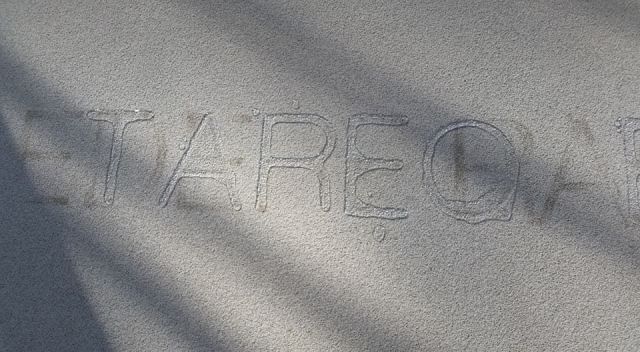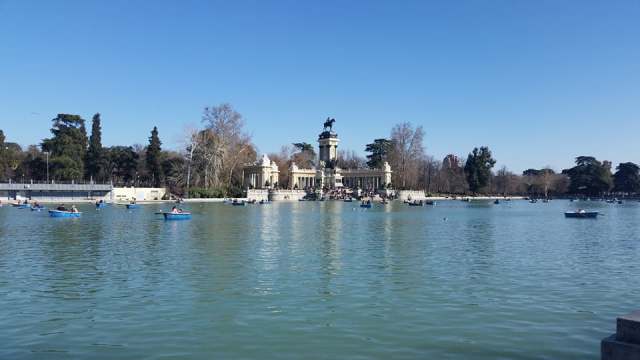The Palacio de Cristal in Madrid’s Parque de Buen Retiro is a large conservatory built for the 1887 Exposition of the Phillippines. For four months recently the Palacio was the home of the minimalist yet deeply poetic installation Palimpsest, by Colombian artist Doris Salcedo, and we were privileged to visit it. This unique work invoked the names, and lost lives, of those who have drowned in the Mediterranean sea and Atlantic ocean while attempting to emigrate to lives of greater peace and freedom in Europe.

Palimpsest took up the entire floor of the Palacio. Bright sunlight filtered through bare winter branches and sparkled through glass before flooding onto stone slabs that formed a canvas on the floor. Into random slabs were carved the names of drowning victims, and a silent hydraulic system below the floors pushed up beads of water that gradually coalesced into still more victims’ names before slowly subsiding back into the stones. Wearing paper booties to spare the floor, guests moved among the names of the dead carefully and quietly. As rhythmically as the surf, names rose up and ceaselessly sank back down.

So often when we speak of dead refugees (if we speak of dead refugees), they are referred to as a collective, anonymous entity. Palimpsest forced reflection on their existence as individuals: persons with names, whose lives were lost at the very moment fear, hope, and bravery converged to impel them forward in their journeys. The resulting commentary crept in more as feelings than thoughts: Shame (on us for accepting and perpetuating dehumanizing language); Grief (with and for the families of these beloved souls); Solidarity (with fellow humans whose lives held precisely the same value as our own). This was no monument; it was a living document, with more names already waiting to be inscribed.

In Richmond this July there was a cool, rainy spell. In every season there is a day or two when you can begin to taste the season to come, and these few days were like that: fairy rings everywhere, spider webs glistening in a near-silent morning rain, and a predawn breeze chilly enough to prompt a jacket. One evening during this spell, sitting near the chimney in our almost-100-year-old house, I could smell the scent of ashes, despite the fact that it now houses a gas fireplace, and the last wood fire was lit many years ago by people we never knew. That scent reaches across the years on cool, damp evenings, as our lives layer over theirs.
Together, the fairy rings, midsummer webs, unseasonably chilly July mornings, and distant smell of cold ash compose a sensory template highly specific to the northeast/mid-Atlantic U.S. where I have lived my entire life. That template is also deeply wedded to the personal narratives I have constructed around it, and the sum effect is a neural pathway so deep and well-defined that perhaps even dementia could never touch it: my own deeply personal experience of home. Likewise, there are billions of other templates across the world, each affording a unique sensory, emotional, and cognitive experience of “home.”
Our internal tug toward the concept of home is primally strong. It is intimately associated with foundational experiences of safety and comfort; the haven of family; and the crucible for our matrices of love. Many of us can reside in that place, or come and go from it as we please, in perfect safety and confidence all of our lives. Yet so many others face torturous choices and, in the face of horror and oppression, unloose forever the cords that bind them to that elemental source of comfort. They make perilous trips over seas, mountains, and borders, and many do not survive. When they perish, their lives layer over other lives also lost along the journey, in concentric circles pressing downward, growing ever fainter – a devastating, heart-wrenching palimpsest.
Irony, if you go in for such things, is never in short supply. A short walk from the Palacio de Cristal is a small ornamental lake, where rowboats can be rented by the hour. On that sunny February day, Madrileños and tourists alike paddled, laughed, and splashed blissfully just a few hundred feet from the Palacio, where droplets forming the names of our drowned dead ebbed and flowed through the cold stone floor; ever upward, and ever again unto the depths.

